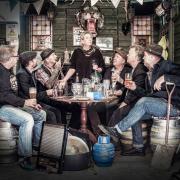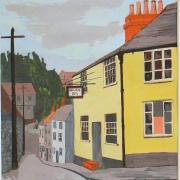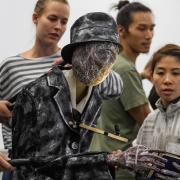Are there really pirates' graves at Church Ope Cove? Edward Griffiths grabs his cutlass and pieces of eight to find out more.
The Mysterious Pirates of Portland
Are there really pirates’ graves at Church Ope Cove? Edward Griffiths grabs his cutlass and pieces of eight to find out more.
The 17th century was the ‘Golden Age’ of piracy on the high seas. The Spanish Main and the busy trade routes around the West Indies were awash with blood-thirsty pirates. Most famous of them all was Henry Morgan whose band of cut-throats raided shoreline towns and looted ships of all nations without mercy. He was rampant in the late 1660s and ferociously active in Panama in 1670. When he died in 1688, there was no shortage of imitators eager to step into his blood-spattered boots.
But what has this to do with Dorset? Well, piracy wasn’t just confined to far-distant seas, and pirates were certainly in action around Britain’s coast including Dorset. Who can be sure that Moonfleet, John Meade Falkner’s tale of Dorset smugglers, came only from his vivid imagination; or that Bournemouth’s resident Scot, Robert Louis Stevenson’s Treasure Island wasn’t influenced by true tales handed down through the generations. Indeed, Old Harry Rocks at Handfast Point on the Isle of Purbeck is named after notorious Poole pirate Harry Paye.
On Dorset’s other ‘Isle’, the fascinating Isle of Portland, the popular name for St Andrew’s churchyard, where the meagre ruins stand teetering on the edge of the east cliffs, has long been ‘Pirates Graveyard’. Built in 1475 on the site of an earlier building, St Andrew’s was destroyed by fire during a French or Danish raid depending whose account you are reading at the time. Its rather romantic reputation as a pirates’ graveyard is based entirely on the fact that some of the headstones and table tombs, both inside and outside the church, have skulls and crossbones carved on them.
Anybody who has read Treasure Island or Arthur Ransome’s Swallows and Amazons will know that pirate ships ran up black flags sporting the infamous white skull-and-crossbones as they closed in on their prey. But does this mean that every tomb that sports a carving of the skull-and-crossbones is the last resting place of a fearsome pirate? Not at all; in fact, the first pirates’ flag was simply blood-red without any decoration, known far and wide as ‘le joli rouge’. This became corrupted over the years into ‘The Jolly Roger’, and the name stayed the same even when the flag was replaced by the skull-and-crossbones. So where did this fearsome insignia come from?
It was first used in monument design in the late-1600s, during the reign of Charles II, as a symbol of mortality. It was seized upon by high-seas’ pirates, as this was exactly the sentiment they wanted it to convey. As the dreaded pirate ship sailed ever closer to its target, the unfurling of this horrifying promise of a short future would have struck terror into the hearts of the simple, highly superstitious seafarers under attack.
So the situation is not as it first appears. Skulls and crossbones on gravestones do not mean that pirates are buried there, it’s just an emblem of mans’ mortality. Pirates ‘borrowed’ this symbol of death as a very effective marketing ploy to petrify their victims, and render them virtually helpless with fear before launching their attack. Not convinced? Let’s have a wander through a few Dorset graveyards and examine the facts.
St Andrew’s Church, Portland
Inspecting the tombs of St Andrew’s more closely, there’s a contemporary tombstone leaning against the wall in the corner of the churchyard, under some overhanging trees at the bottom of the footpath steps. Dating to 1684, this one is decorated with an hour-glass, just as unsettling in its own way as the skull-and-crossbones. There are two table tombs nearby, one of which belongs to Owen Benfield, but it doesn’t have a skull or any crossbones. The tomb behind Mr Benfield’s does have the skull-and-crossbones design. This belongs to a lady whose name has been worn away by time and weather. But the rest of the inscription clearly shows that she died on ‘January 1699 in the 49th year of her age’, and that she wasn’t a pirate at all.
On the southern slopes, there are some smaller headstones with variations of the skull-and-crossbones design. One is for ‘Julan wife of Robert Biett’ who died in May 1691, and another is for John Ayles who died in June 1723 aged 42. In the aisle of St Andrew’s Church, there’s a headstone for Andrew Stone who died in 1704 aged 80. This simple stone has small crossed bones but no skull, and is just another of several variations to the basic design.
Whitcombe Parish Church
Further inland, at one of Reverend William Barnes’ churches, there is a table-tomb of the same period; again with the same skull-and-crossbones mortality motif. Close to the ancient preaching cross in the churchyard of Whitcombe Parish Church, near Dorchester, a Portland stone tomb with elegant classical lines carries a Latin inscription commemorating ‘Melchisedeck Gillet who died aged 75 on 6th September 1680, and Christiane his wife’. Neither of these dear souls, with such wonderful names, sounds much like a pirate.
St George’s Church, Portland
In the mid-18th century, St Andrew’s Church Committee came to the conclusion that they couldn’t afford to keep repairing the wall that was shoring up the churchyard and the church. So they abandoned the old church, knowing it would eventually slide into Church Ope Cove below. They replaced it with a much bigger church at Easton. St George’s Church was completed in 1765. By this time, the skull-and-crossbones had fallen out of favour and so examples after 1765 are extremely rare. One of the last can be found in the churchyard on the south side of St George’s, on the highly decorated headstone of ‘Susanna wife of Edward Pearce, died January 1771’. Significantly, the design had already been modified. The skull has been placed centrally with a single bone on either side.
Also worthy of a mention is a magnificent Portland stone table-tomb in the graveyard of St Martin’s Church in Martinstown, Erected for Henry Stevens, who died in March 1708, it has a charmingly na�ve carving of a grimacing skull, with deeply sunken eye-sockets, flanked by two pairs of crossed-bones. I also recently discovered a particularly imaginative tombstone at St Michaels’ Church in Stinsford, just a few yards from Thomas Hardy’s heart-burial. Erected for Jane, wife of John Knight, who died on 23 May 1755 aged 85 years, it’s decorated with a single skull (top half only) with a bat’s wing on either side. Even though its not strictly a skull-and-crossbones, it’s still a rather spooky piece. There are many more examples of skull-and-crossbones designs to be discovered across Dorset, maybe you know of some? But, I think we’ve laid the myth of cut-throats of the high seas residing in our Dorset churchyards to rest now.
So tread quietly and look kindly upon the resting souls. They’re not really pirates, after all.


























